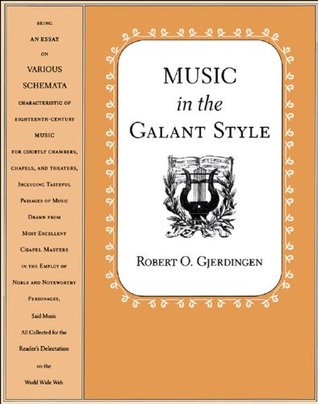Kindle Notes & Highlights
hallmark of the galant style was a particular repertory of stock musical phrases employed in conventional sequences.
Even J. S. Bach, whom the general public has long viewed as the paradigmatic Baroque composer, created galant music when it suited his and his patrons’ purposes.16
The popular view of the composer—a Romantic view inherited from the nineteenth century—does not fit eighteenth-century reality. The composer of galant music, rather than being a struggling artist alone against the world, was more like a prosperous civil servant.
In short, the galant composer lived the life of a musical craftsman, of an artisan who produced a large quantity of music for immediate consumption, managed its performance and performers, and evaluated its reception with a view toward keeping up with fashion.
Many composers played up this perceived break with the past, and a by-product of their musical modernism was the retrospective formation of a preceding “common-practice period.” In particular, eighteenth- and nineteenth-century musics became lumped together as a pre-Modern style that came in three standard flavors—Romantic, Classical, and Baroque. The appeal and convenience of this construction, with its master narrative of musical growth and progress aided by the invisible hand of tonality and developments in the “science” of harmony, no doubt led to its wide acceptance. Yet as a prime
...more
Many performers can recite a lineage that extends from their own principal teacher back through a chain of teachers to the time of Beethoven or beyond. The great Chilean pianist Claudio Arrau (1903–1991), for example, was a proud student of Martin Krause (1853–1918), who was a student of Franz Liszt (1811–1886), who was a student of Carl Czerny (1791–1857), who was a student of Ludwig van Beethoven (1770–1826), who was a student of Joseph Haydn (1732–1809), who was a student of Nicola Porpora (1686–1768), who was a student of Gaetano Greco (ca. 1657–1728). Greco taught the first generation of
...more
LOCAL KEY VERSUS GLOBAL TONALITY. The relationship between local and global meanings of chords and keys was fluid in galant music. Many of the methods of musical analysis in vogue today often overstate the degree to which one can clearly distinguish between local and global significance. Indeed, the craft of the galant composer depends heavily on the ability to modulate between perceived certainty and uncertainty, between, on the one hand, giving the courtly audience a sense of security and groundedness and, on the other hand, taking listeners down dark alleys of strange chords and keys where
...more
Today we tend to equate “compose” with “invent,” yet the older, more literal meaning of “put together” (com + posare) may provide a better image of galant practice.
Part of the difficulty resides in the word “key.” By the second half the century—Clementi’s time—the meaning of “key” was approaching its modern sense, as in “the key of B♭ major.” In the first half of the century, “key” could also imply a note in a scale that received some temporary focus, as in “G—the sixth key in the hexachord on B♭.” If we examine a repertory from the first half of the century, we ought to find more of the practices that were not yet “obliterated.”
The gradual transition from a galant to a more bourgeois music culture accelerated during the final decades of the eighteenth century. Obviously the revolution of 1789, which led to a crisis for French aristocrats and the bishops of the Church, created a concomitant crisis for the many musicians whom they supported.
In speaking disapprovingly of an inexperienced instrumentalist who would try his hand at writing a solo sonata (soloist plus thoroughbass), Quantz commented, “If he lacks knowledge of the rules of composition, he has someone else write the bass.”17 The sense that a bass contained the essential trace of the musical path was widespread and explains to some extent why partimenti were so common in the training of future composers.
As a continuous, mostly one-voice blueprint for realizing a polyphonic composition, an advanced partimento shares many features in common with what scholars of composers’ sketches often term a “continuity draft.” Indeed, someone unacquainted with partimenti could easily mistake a manuscript copy of an advanced partimento for a composer’s sketch.
The French Revolution (1789) had begun a long series of dislocations and upheavals that weakened the galant social order. Napoleonic armies overturned, bankrupted, or threatened almost every court in Europe, including the Church. When nearly thirty years of instability ended with the Treaty of Vienna (1818), prerevolutionary life was but a distant memory.


